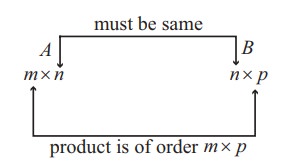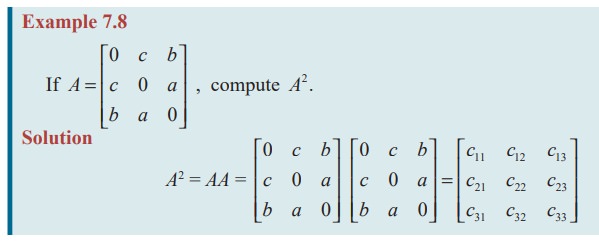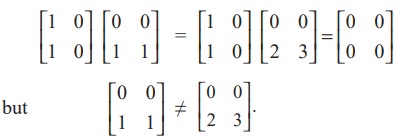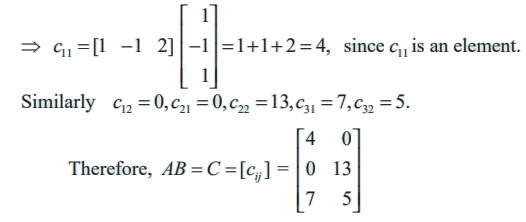Solved Example Problems - Algebraic Operations on Matrices | 11th Mathematics : UNIT 7 : Matrices and Determinants
Chapter: 11th Mathematics : UNIT 7 : Matrices and Determinants
Algebraic Operations on Matrices
Algebraic Operations on Matrices
Basic operations on matrices are
(1) multiplication of a matrix by a scalar,
(2) addition/subtraction of two matrices, and
(3) multiplication of two matrices.
There is no concept of dividing a matrix by another matrix and thus, the operation A/B , where A and B are matrices, is not defined.
(1) Multiplication of a matrix by a scalar
For a given matrix A = [aij ]m×n and a scalar k, we define a new matrix kA = [bij ]m×n , where bij = kaij for all i and j.
For instance, if

In particular if k = −1 , we obtain − A = [ −aij ]m×n . This - A is called negative of the matrix A.
Don’t say - A as a negative matrix.
(2) Addition and Subtraction of two matrices
If A and B are two matrices of the same order, then their sum denoted by A + B, is again a matrix of same order, obtained by adding the corresponding entries of A and B.
More precisely, if A = [ aij ]m× n and B = [bij ]m×n are two matrices, then the sum A + B of A and B is a matrix given by
A + B = [cij ]m×n where cij = aij + bij for all i and j.
Similarly subtraction A - B is defined as A − B = A + ( −1) B.
That is, A − B = [d ij ]m×n , where d ij = aij − bij ∀ i and j. (The symbol ∀ denotes for every or for all).
Note 7.2
(i) If A and B are not of the same order, then A + B and A - B are not defined.
(ii) The addition and subtraction can be extended to any finite number of matrices.
Example 7.4
Compute A + B and A - B if

Solution
By the definitions of addition and subtraction of matrices, we have

Example 7.5
Find the sum A + B + C if A, B, C are given by

Solution
By the definition of sum of matrices, we have

Example 7.6
Determine 3B + 4C - D if B, C, and D are given by

Solution

Example 7.7
Simplify :

Solution
If we denote the given expression by A, then using the scalar multiplication rule, we get

(3) Multiplication of matrices
Definition 7.15
A matrix A is said to be conformable for multiplication with a matrix B if the number of columns of A is equal to the number of rows of B.
That is, if A = [ a ij ]m× n and B = [b ij]n× p are given two matrices, then the product of matrices A and B is denoted by AB and its order is m × p.
The order of AB is m × p = (number of rows of A)× (number of columns of B).

If A = [a1 a2 ... an ]1×n and B =  ,then AB is a matrix of order 1 × 1, that gives a single element which is defined by
,then AB is a matrix of order 1 × 1, that gives a single element which is defined by


where c11 =  = 0 ⋅ 0 + c ⋅ c + b ⋅ b = c 2 + b2 and other elements cij may be computed similarly.
= 0 ⋅ 0 + c ⋅ c + b ⋅ b = c 2 + b2 and other elements cij may be computed similarly.
Finally, we easily obtain that


Note 7.3
We have the following important observations:
(1) If A = [aij ]m× n and B = [bij ]n× p , and m ≠ p, then the product AB is defined but not BA.
(2) The fundamental properties of real numbers namely,
ab = ba ∀a ,b ∈R
ab = ac ⇒ b = c ∀ a,b, c ∈R, a ≠ 0
ab = 0 ⇒ a = 0 or b = 0 ∀ a ,b ∈R
Can we discuss these in matrices also?
(i) Even if AB and BA are defined, then AB = BA is not necessarily true.
For instance, we consider

and observe that AB ≠ BA, since

In this case we say that A and B do not commute (with respect to multiplication)
Observe that AB = BA is also possible. For instance,

In this case we say that A and B commute with respect to multiplication.
(ii) Cancellation property does not hold for matrix multiplication. That is, A ≠ O, B, and C are three square matrices of same order n × n with n > 1, then AB = AC does not imply B = C and BA = CA does not imply B = C.
As a simple demonstration of these facts, we observe that for instance,

(iii) It is possible that AB = O with A ≠ O and B ≠ O; Equivalently, AB = O is not necessarily imply either A = O or B = O. The following relation demonstrates this fact :

(3) In general, for any two matrices A and B which are conformable for addition and multiplication, for the below operations, we have
(A±B)2 need not be equal to A 2±2 AB B2
A 2-B2 need not be equal to ( A+B)( A-B).
Example 7.10

Solution
The order of A is 3 × 3 and the order of B is 3 × 2. Therefore the order of AB is 3 × 2. A and B are conformable for the product AB. Call C = AB. Then,
c11 = (first row of A) (first column of B)
Similarly c12 = 0, c21 = 0, c22 = 13, c31 = 7, c32 = 5.

The product BA does not exist, because the number of columns in B is not equal to the number of rows in A.
Example 7.11
A fruit shop keeper prepares 3 different varieties of gift packages. Pack-I contains 6 apples, 3 oranges and 3 pomegranates. Pack-II contains 5 apples, 4 oranges and 4 pomegranates and Pack –III contains 6 apples, 6 oranges and 6 pomegranates. The cost of an apple, an orange and a pomegranate respectively are Rs. 30, Rs. 15 and Rs. 45. What is the cost of preparing each package of fruits?
Solution
Cost matrix A = [30 15 45],

Cost of packages are obtained by computing AB. That is, by multiplying cost of each item in A (cost matrix A) with number of items in B (Fruit matrix B).

Pack-I cost Rs. 360, Pack-II cost Rs. 390, Pack-III costs Rs. 540.
Related Topics